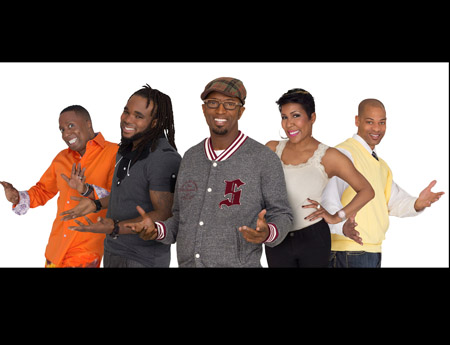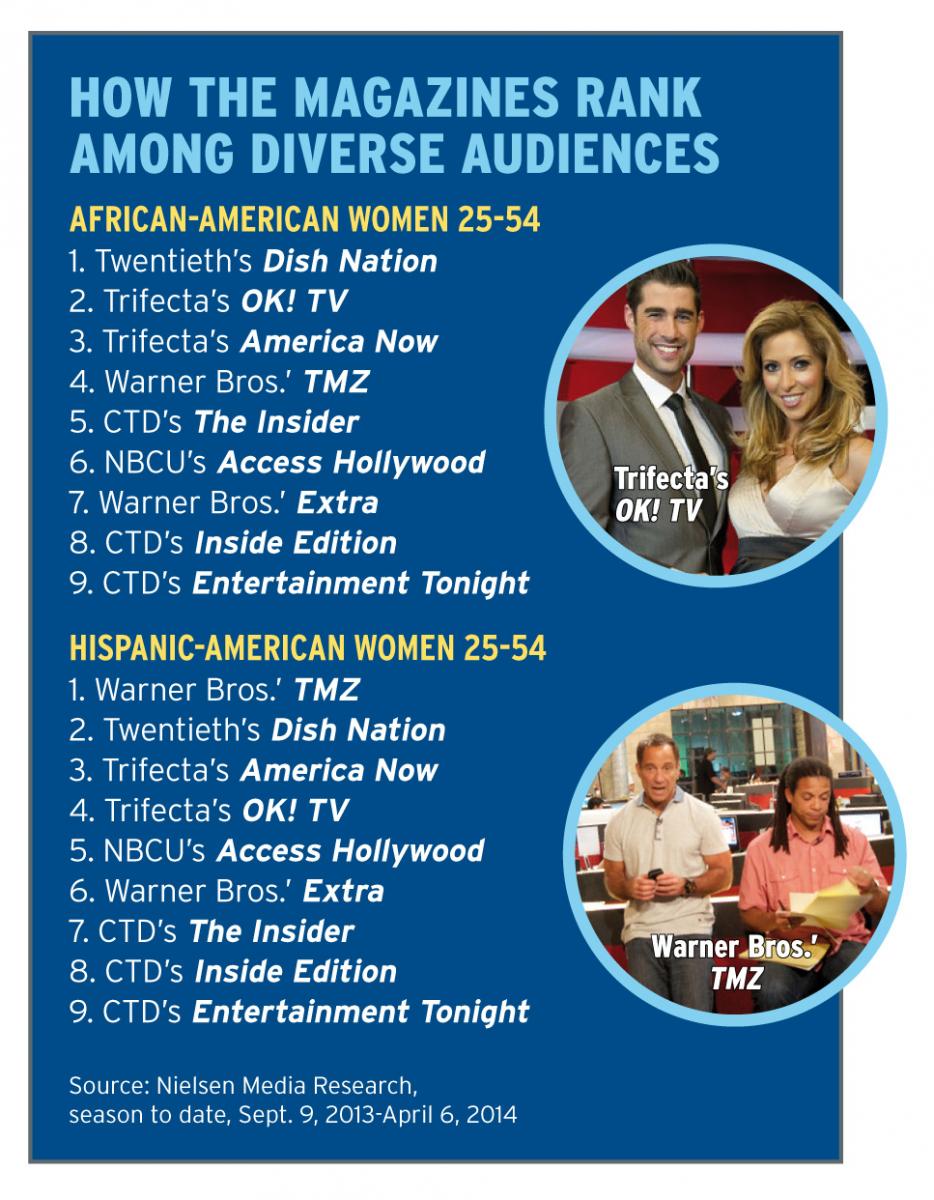Entertainment ‘Zines Look To Add Youth, Color, Viewers

CBS Television Distribution's Entertainment Tonight is by far the magazine leader when it comes to every age-based demographic, from households to viewers to women 25-54 to men 18-34.
But those rankings shift when you look at how the entertainment magazines rank among millennial audiences and viewers of color, both of which are becoming increasingly important to daytime television programmers.
One of syndication’s newest entertainment magazines, Twentieth’s Dish Nation, is actually a surprise winner. It is syndication’s youngestskewing show, with a median age of 46; it’s also the top-ranked show among African-American women 25-54 and ranks second among Hispanic-American women in that same age group, according to Nielsen Media Research.
Dish Nation—which compiles funny clips from drive-time radio shows in Atlanta, Dallas, Los Angeles and Seattle—averaged a 0.9 household rating in the week ended April 13; while that’s significantly lower than the category’s major players, the show’s young and diverse appeal gives it the advantage of being something different.
“The bottom line is that when you talk about the cultural shift in the country, a lot of times as programmers we don’t take that into consideration,” says Stephen Brown, Fox Television Stations’ executive vice president of programming and development. “I think that when you look at the cast of Dish Nation, they are diverse in appearance but also in the way they look at the world.”
Michael Bachmann, Dish Nation’s executive producer, says the show’s “first goal is just to find the funny in every story,” adding, “But with any city there’s diversity, and when we cast the show, we wanted to make sure we represented a lot of voices.”
Dish Nation’s cast includes the talent from Atlanta’s “Rickey Smiley Morning Show”; Dallas’ “Kidd Kraddick in the Morning”; Seattle’s “Brooke & Jubal in the Morning”; and Los Angeles’ “Heidi & Frank.” All four groups span the diversity spectrum, including white, black, Asian, Hispanic, gay and straight among the radio deejays that appear on the show each day.
Broadcasting & Cable Newsletter
The smarter way to stay on top of broadcasting and cable industry. Sign up below

“I’d be lying to you if I said our first intent when we cast the show was to have this broad spectrum of cultures that would appeal to a younger audience,” Brown says. “What we were looking for were funny syndicated radio programs that offered different perspectives. But the happy accident was that with all of these diverse team members, we realized that the show did have a very unique take on the world around us.”
Diversity Pays
That diverse point of view is something that other entertainment-magazine producers also look to capture.
“We’re taking a bunch of different viewpoints and putting them together as a tapestry,” says Brad Bessey, who now oversees both Entertainment Tonight and The Insider for CBS Television Distribution. “If you ignore some of the different colors that make this tapestry, then you are ignoring part of your audience. I’m always looking for ways to interweave these voices.”
CTD’s The Insider also has a ways to go to climb up the overall ratings chart, typically ranking sixth behind Warner Bros.’ Extra, but among both African-American and Hispanic- American women, it outperforms Entertainment Tonight, which ranks last on both indices. Adding some diversity to Entertainment Tonight’s cast is one of Bessey’s priorities in his new role at the show.
“There are millions of people watching TV, and they don’t all have white skin,” Bessey says. “If you really get into the conversation of what’s going on in the world of entertainment, then you have to talk about diversity and serving a diverse audience.”
While a glance at the various casts of the entertainment magazines shows that the majority of hosts and correspondents are white, offering diverse talent both in front of and behind the camera is a growing trend.
Both Extra and The Insider are hosted by men of color—Hispanic-American Mario Lopez and African- American Kevin Frasier, respectively. And Warner Bros.’ TMZ, syndication’s second-youngest skewing show, features a wide cast of young and diverse faces who gather to chat in Harvey Levin’s newsroom about the pop-culture news of the day.
“The audience expects to see themselves on the air, and if we don’t do that, we do it at our peril,” Brown says. “No one really cares what your racial background is; it’s really more about your attitude, your perspective and how you present your ideas.”
Contributing editor Paige Albiniak has been covering the business of television for more than 25 years. She is a longtime contributor to Next TV, Broadcasting + Cable and Multichannel News. She concurrently serves as editorial director for The Global Entertainment Marketing Academy of Arts & Sciences (G.E.M.A.). She has written for such publications as TVNewsCheck, The New York Post, Variety, CBS Watch and more. Albiniak was B+C’s Los Angeles bureau chief from September 2002 to 2004, and an associate editor covering Congress and lobbying for the magazine in Washington, D.C., from January 1997 - September 2002.

